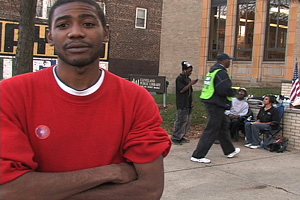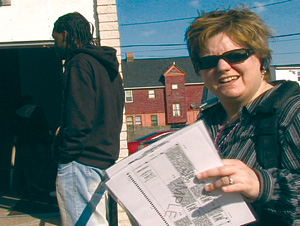Videoing the Vote
BUFFALO, N.Y. So how many videographers does it take to help the world's foremost democracy achieve its fairest (presidential) election in over a decade? Based on this year's results, perhaps a few thousand or so (beyond the working press). That's how many persons officially participated in "Video the Vote"'s first presidential election effort in 2008. Video the Vote (VtV) was launched in 2006 in response to bipartisan charges of vote stealing, voter suppression and fraud etc. which marred the prior two presidential elections in 2000 and 2004).
In response, assorted grass roots initiatives were launched to prevent and discourage many of these abuses in future elections. The aim of VtV was to capture voting abuses, or at least first hand accounts, on video, and to make this widely available, online and on TV. "We want to expose how elections are manipulated and votes suppressed in elections and to help make them a bit fairer by sharing this with millions of Americans," said VtV co-founder, John Ennis. More than 3,000 persons volunteered to particpate in VtV this year, many of them seasoned videographers but with many concerned amateurs as well.

More than 3,000 volunteer camera operators monitored polling places. My own decision to participate in VtV harks back to the 2004 presidential election when I volunteered as an election monitor in Columbus Ohio, ground zero on the election roadmap for both presidential candidates. At every polling place we visited, on Columbus' heavily black East Side, and in university precincts, long lines of voters waited for hours in the rain to vote due to a shortage of voting machines. The persistent rain caused lens fogging, and permeated the audio track, but the biggest problem was moving the video afterwards.
Also, as an election monitor, I had limited time to shoot video, let alone to edit or get it to a TV news hub from a laptop. Wifi networks weren't nearly as prevalent then as now, so locating a network then wasn't nearly as easy as it is today.
This year I wanted to spend all of my time shooting the election and any problems that might crop up, and also to be able to quickly get it to TV news outlets too, if noteworthy, and to post it online. VtV's partnership with (units within) PBS, CNN, New York Times, etc., and also with YouTube, made it feasible to access both pipelines via their Web site, at least theoretically.
ONE MAN BAND
As a shooter working with VtV, all I needed, besides my camera package, was a computer and a broadband connection to feed edited footage to the VtV Web site. They were equipped to handle a variety of file formats captured and edited on either a PC, a Mac or an IntelMac. Because a substantial minority of their volunteers were rank amateurs, video-wise and didn't have their own editing software, VtV even provided uploading instructions for footage captured in free editing software bundled with Mac and PC OS's. Naturally, they were ready to work with files output from most major NLEs too, like Final Cut, Avid Express and Vega, for example, by having all participants output to universal file formats like H.264 (before uploading to their Web site) at broadcast resolution (720x480) and data rates (2000 kbps) at manageable file sizes—all critical when transmitting files over the Internet. They also wanted file sizes accessible to persons with dialup as well as broadband connections.
To do this VtV designed a one stop portal for uploading and downloading. The H.264 files were ingested at full quality and could be downloaded at full quality from their Web site as well. For online viewing, the files were further compressed by VtV partner, You Tube, using Adobe Flash, a very efficient codec for Web streaming. This was critical as the VtV site on YouTube was anticipating a high volume of video of unknown length, within 48 hours of election day. In an effort to manage the data load VtV urged all contributors to keep clips under 3 minutes, although it didn't block larger clips from being uploaded.

To get everyone playing from the same rulebook all VtV volunteers had to undergo "basic training," which emphasized shooting protocol around polling stations: how to document an election without affecting it, or breaking the law. There were also detailed instructions on their Web site including compressing and uploading specs for both PC and Mac users… plus details on legal releases, logging, credentialing, etc.
On election day, by the time I met up with Cleveland's VtV coordinator, Dan Kozminski at 7:30 a.m., I'd already heard radio reports of long lines at Cleveland-area polling places and expected a repeat of the chronic long lines of the 2004 election, minus the rain. In fact, our first two calls were to polling stations which reported early long lines. But, in both cases, the lines had dissipated by the time we arrived. At several East Side polling places plagued with long lines all day in 2004, we were met by volunteer election protection lawyers and other monitors, and no visible bottlenecks or notable voting irregularities to record. In fact, once the lines vanished by mid-morning, we stopped getting calls from dispatch, and kept busy by visiting polling places where problems abounded in 2004.
After the polls closed, the task of editing and uploading the days' interviews began. This took another several hours, spilling into the next morning, not due to any bottlenecks on the Web site, but because we experimented with different encoding options, using Vegas, (which I was unfamiliar with). Ultimately, the compression specs specified by VtV proved the most efficient and enabled a fast, smooth upload which looked surprisingly good on YouTube. Within a week of the election, Video the Vote registered over a million hits on roughly 1000 video clips.
DRAMATIC IMPROVEMENT
Within a week of the election, VtV registered more than 1 million hits on 1,100+ video clips.
The videos will remain online for the indefinite future. At presstime there was no information on how many election day clips were used by media organizations to bolster their election coverage, but some pre-election day reports by VtV on alleged efforts to suppress the black vote in Indiana and in Florida were widely used by various TV news organizations according to Ennis. "Our pre-election reports helped prevent thousands of black voters from being disenfranchised in the 2008 election. My hope is that by spotlighting these abuses we can reduce them, like the Help America Vote Act intended," Ennis said.
Overall, the technical quality of election day coverage by VtV volunteers improved dramatically over 2006. "Camera quality has improved a lot even in the past two years," Ennis said. "Many of our volunteers had their own HDV camera packages, including pro mics, lights, etc., hence a lot of the footage ingested was in 16:9 and HD. We were even able to provide a few hundred flip camera to volunteers who didn't have cameras. They record to flash, which made uploading much faster and easier. An HD camera for under $300 is a great asset for a grassroots organization like Video the Vote."
The professional video industry's #1 source for news, trends and product and tech information. Sign up below.
